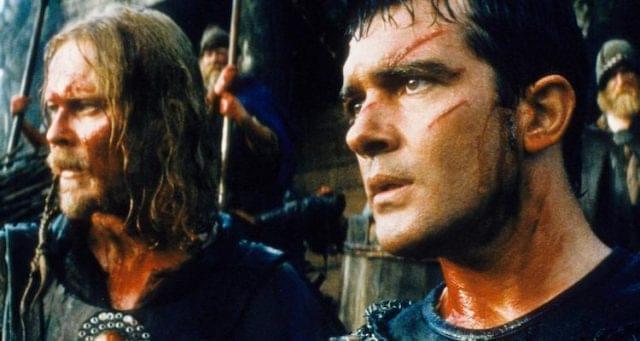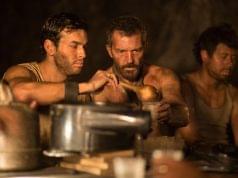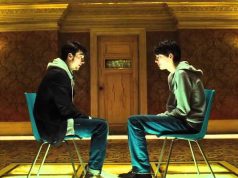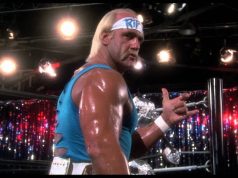
Here are my main complaints about “The 13th Warrior,” starring Antonio Banderas as a 10th-century Arab Muslim who goes on an adventure with Norse Vikings:
– It stars Antonio Banderas as a 10th-century Arab Muslim.
– He goes on an adventure with Norse Vikings.
What? I mean, honestly: What?
We know we’re in trouble immediately, when the first dialogue is Banderas introducing himself in a voice-over: “I am Abhhammdddmambh ibn Bhmmahamajaja.” (I’m paraphrasing.) Banderas, talented and smoldering though he may be, is not very, how you say, articulate. It’s hard enough to understand him when he’s speaking English, let alone English tinged with Arabic names.
Moreover, the Vikings speak, I don’t know, Viking, or Latin, or something. Banderas’ character, whose name turns out to be Ahmed (thanks, Wikipedia!), doesn’t speak their language, but he has a buddy with him, an old man named Mxyzptlk (or something), and he speaks Viking. So he translates for Ahmed.
To summarize: Ahmed speaks “Arabic,” which is presented to us in barely decipherable Spanish-accented English. The Vikings speak whatever it is they speak, and Mpxqlxkj translates. Thus, for the first 20 minutes, everything the movie wants to tell us takes twice as long as it should. The language barrier is there to make the story seem more realistic. Then, just as realistically, Ahmed becomes fluent in the Viking tongue simply by hanging out with the Norsemen for a couple weeks. You know how people go to Cancun for a vacation and come back speaking perfect Spanish? It’s like that. So I applaud the filmmakers for their dedication to verisimilitude (or, as Banderas calls it, “farrisamaledute”).
Ahmed and his buddy, who is played by Omar Sharif, are out galavanting because Ahmed got exiled from Baghdad for being too, how you say, sexy. Too sexy with the caliph’s wife, that is. (“Caliph” is an example of a word that your brain has to contemplate for several seconds before it realizes that’s what Banderas is saying.) So they’re in the north lands, just riding around on horseback, when they come upon a Viking funeral for a king who has just died. Viking funerals are among the best funerals in the world because they involve heavy drinking and fire, making them essentially no different from a Southern barbecue.
Ahmed and Omar Sharif make friends with the Vikings and have some brewskis before learning that there’s trouble back in Vikingland. It seems King Rahthgaaar (or something) is under attack by marauders. Luckily, the Vikings have a witch with them, and she throws some bones on the floor, and from this she determines that they need to send thirteen warriors back to Vikingland to help King Raaahthhgaar fight off the invaders. Why thirteen? One for every month of the year, she says. No one questions her on this. No doubt they’ve been listening to the delusional rantings of this particular witch for decades.
Twelve Vikings volunteer for the mission, leaving Ahmed to be the thirteenth. As luck, fate, and insane old women would have it, the thirteenth warrior is supposed to be a non-Norseman anyway, so it’s a good thing Ahmed was handy, and that no other Norseman wanted to go. I mean, seriously: whew.
Ahmed doesn’t really want to go to war, though. He’s a lover, not a fighter. (This is where Glenn Beck storms out of the theater in disgust. “An Arab Muslim who doesn’t want to kill people? Pure liberal Hollywood fiction!”) But duty calls, and so Ahmed and the dürty dözen make haste for Vikingville. When they arrive, it becomes obvious why this particular village is always being attacked by malicious outsiders: It doesn’t have any *@&!@ walls. Nor does it have moats, fences, or barricades. It doesn’t have anything, not even a guard station where visitors have to sign in. I know it’s not P.C. to blame the victim, but come on, Scandilazians. You can’t always expect a band of freelance knights to come bail you out.
The villagers are terrified of the marauders, who they believe are non-human monsters. Urban legends — well, rural legends, I guess — have sprung up around them, describing them as bear-human hybrids with fangs and claws and a fondness for honey. (The usual method for determining whether someone is a bear didn’t work in the Dark Ages, because everyone pooped in the woods.) Ahmed and his new Viking pals do battle with them when they make their customary twice-weekly pillaging, and the shocking truth is discovered: They’re not bears at all! They’re just a bunch of weirdos who paint their faces and wear bearskins as costumes in order to frighten dumb villagers!
Still, that doesn’t solve the problem of how to stop them from killing everyone in the village. The first step is to build some walls, for crying out loud. While that’s going on, some in-fighting develops within Ahmed’s crew, and I’d be lying if I said I had any idea what the conflict is, or even what any of the characters’ names are. There are twelve of them, and I think only three are ever mentioned by name, and even then it’s always something like “Baowølf” or “Hrrgrr” or some other Ikea-furniture-sounding name, and not to be racist, but all Norsemen look alike to me. I’m sorry, I’m just sayin’.
Finally, after some halfhearted flirtations with village women and lame attempts at subplots, the thirteen warriors set out to attack the bear-men in their own lairs. They do this successfully, and the bear-men are vanquished. It might sound like I’m glossing over the climax, but really, that’s pretty much how the movie presents it. The more important thing is that Ahmed and the Norsemen are friends now, despite their cultural and religious differences. The day may come when they will slaughter each other as infidels. But that day is not today! They will probably need to learn each other’s names first.
— Film.com





